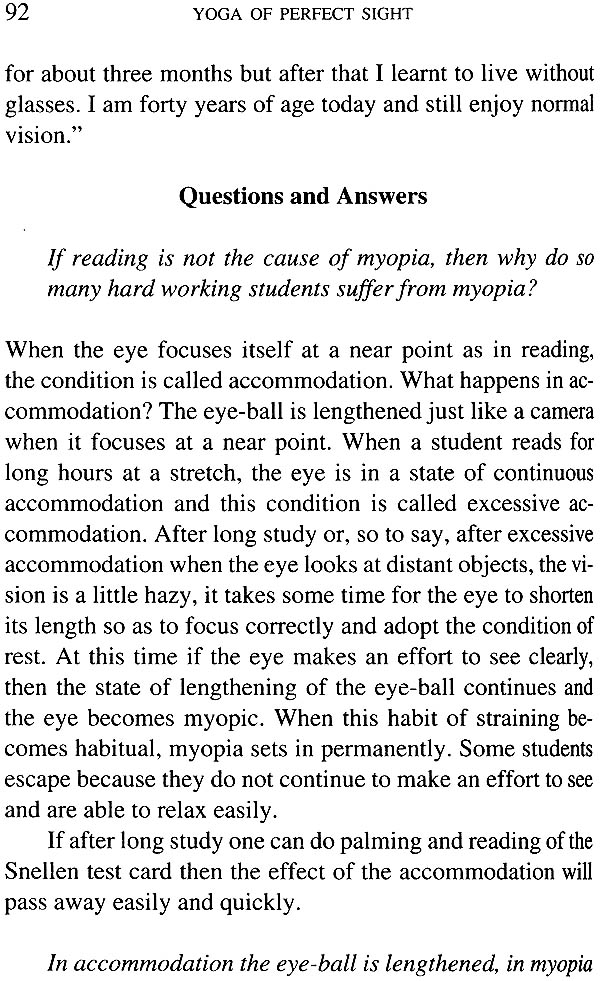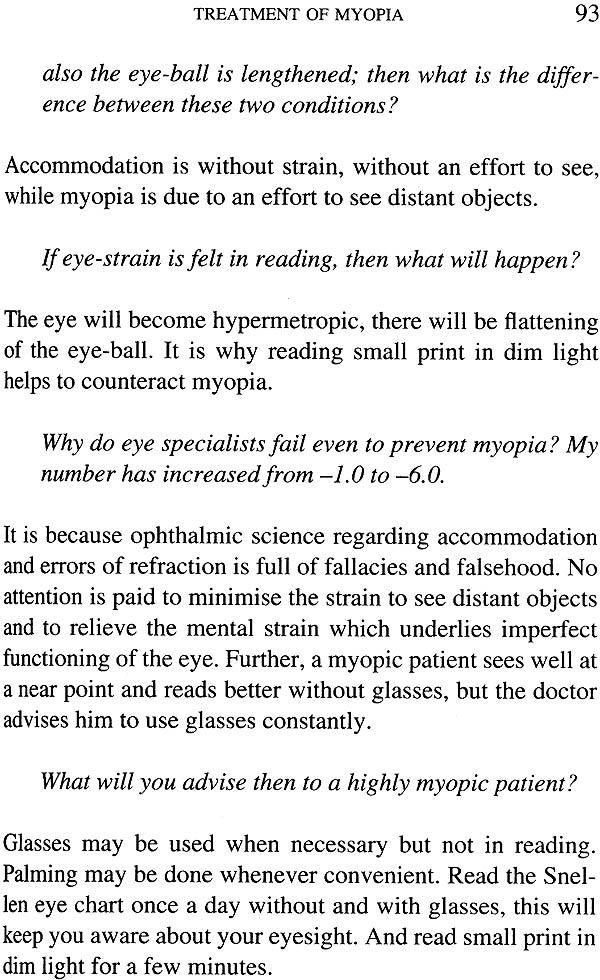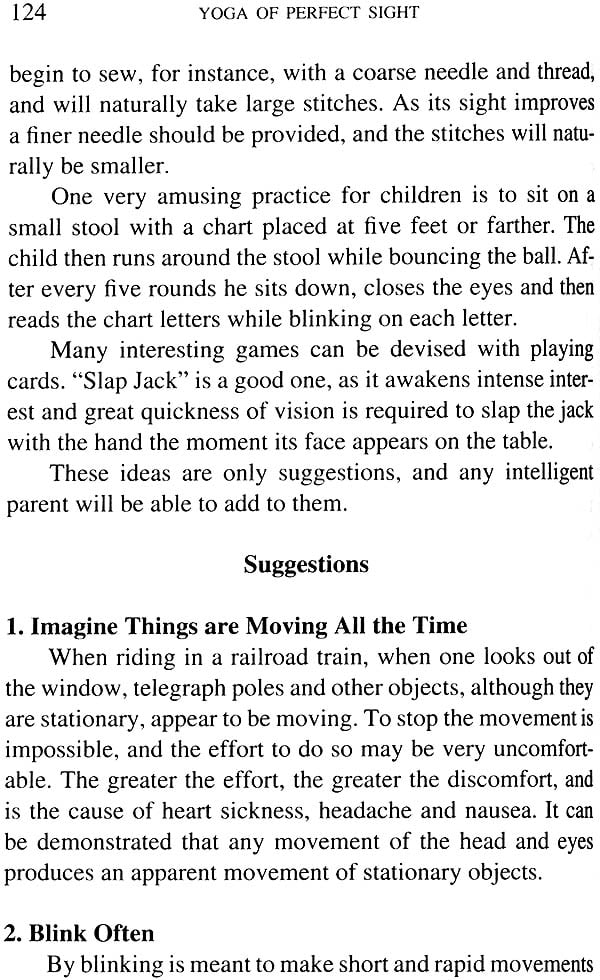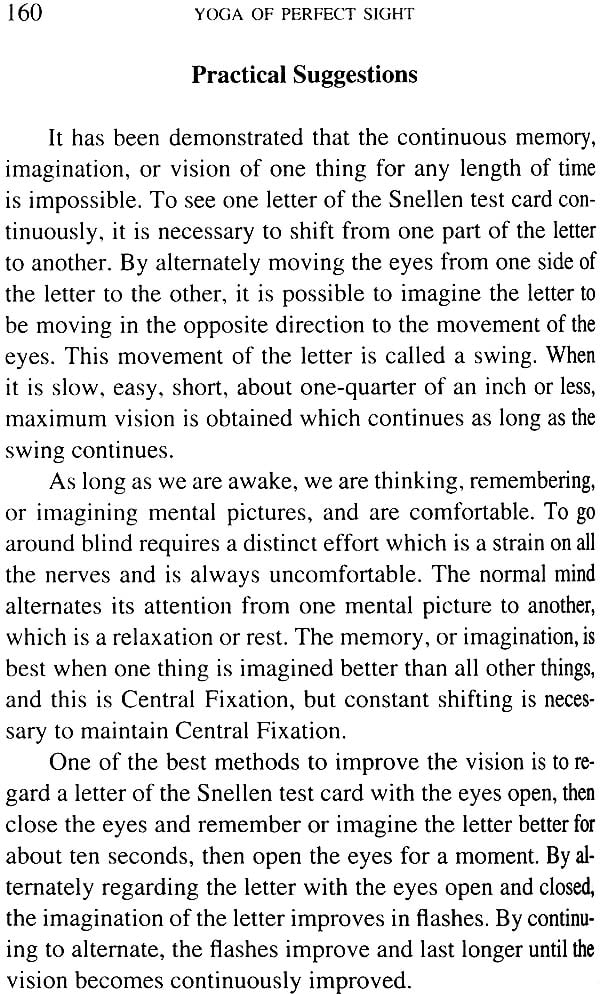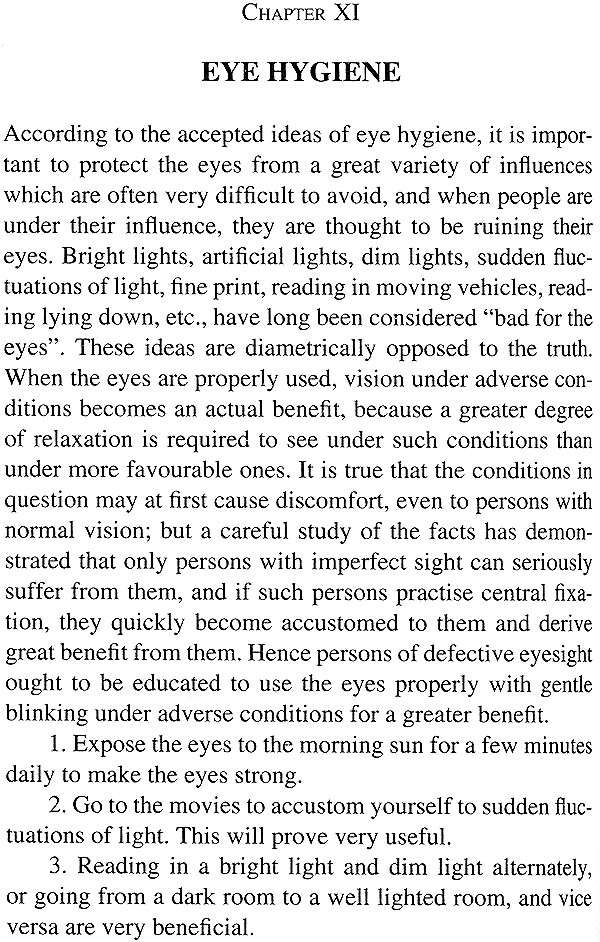
Yoga of Perfect Sight
Book Specification
| Item Code: | NAC221 |
| Author: | Dr. R. S. Agarwal |
| Publisher: | Sri Aurobindo Ashram, Pondicherry |
| Language: | English |
| Edition: | 2017 |
| ISBN: | 9788170589839 |
| Pages: | 223 |
| Cover: | Paperback |
| Other Details | 7.5 Inch X 5.0 Inch |
| Weight | 190 gm |
Book Description
WHAT A MARVEL IS THE EYE! As simple as an animate miniature camera, as sublime as the gift of vision.
When our vision is normal we hardly notice the wonder of sight; but when it deteriorates, suddenly we become aware of Nature’s great gift— irreplaceable eyesight.
Is there a natural way to improve defective vision and, in many cases, restore it to normal? “Yes”, says Dr R. S. Agarwal, a pioneer in the field of holistic eye care. His book, Yoga of Perfect Sight, is a comprehensive manual on the natural care of the eye. It explains how to maintain healthy eyes by adopting a few good habits of eye care — habits that keep the eyes relaxed, refreshed and at ease. And it gives simple but effective exercises to improve one’s eyesight.
Because everyday life strains our eyes, the eye muscles get weakened and our vision declines. But just as other muscles of the body can be strengthened through proper exercises, so the eye muscles can become strong and healthy again. By gently relaxing, stretching and strengthening the eye muscles, we improve their health and thus improve our vision. This book shows how to do this safely and effectively.
The book contains chapters on the discoveries of Dr W. H. Bates, on the physiology of the eye, and on the natural cure for many major eye problems. There are also interesting case histories, question-and-answer sections, and letters on eyesight and Yogic vision by Sri Aurobindo.
Dr R. S. Agarwal, founder of The School for Perfect Eyesight at The Sri Aurobindo Ashram, Pondicherry, India, started his career with a medical degree. His practice combined allopathy and naturopathy with the Bates Method and the Integral Yoga of Sri Aurobindo. The discoverer of a synthesis in ophthalmic science, his aim was to create a new type of doctor, a spiritualised doctor of the future, more concerned with health than with pathology, one who could bring to his patients perfect eyesight in a natural way.
This book is a collection of articles written by my father, Dr. R. S. Agarwal. Most of the articles were first published in Mother India, a monthly journal of Sri Aurobindo Ashram, Pondicherry. The last chapter includes letters of Sri Aurobindo about eyesight and Yogic vision.
The author has added some more experiences in this new edition.
Almost every eye specialist of the world believes that for refractive errors there is not only no cure but practically no preventive also. From such a belief any rational mind will conclude that science is in a very imperfect stage. What some writers on Ophthalmology wrote two hundred years back about the incurability of the refractive ailments, is continuing as a dogma even today, in the days of advanced science. We are so much hypnotised by the assertions of the old authorities that we do not care to make any experiment or do some research on the subject. And if anyone comes forward to say that cases of errors of refraction can be improved without glasses, we begin to doubt and without any study discard his explanation. Such is the condition of our mind which is supposed to be scientific. A scientific mind is always open to admit a truth or a fact.
The old writers tell us that the visual organ of man was never intended for the uses to which it is put now. In the early ages there was no school, no printing press, no electric light and no moving pictures. In those days the eye served the needs of the human animal perfectly. Man was a hunter, a farmer, a fighter; he needed only distant vision for which no muscular action was required. It is in near vision that some muscular action is required to correct the focusing, but at that time the use of eyes for near was rare and of very short duration.
When man learned how to communicate his thoughts to others by means of written and printed forms, there came some undeniably new demands upon the eye, affecting at first only a few people but gradually including more and more, and now in the most advanced countries the great mass of the population suffers from defective vision. Since the tallow candle has been displaced by the various forms of artificial lighting and the moving pictures have come in to use, almost every one suffers from some form of refractive error.
The prevailing method of treatment for the errors of refraction is by means of compensating lenses. But very little has ever been claimed except that these contrivances neutralise the effects of the various conditions for which they are prescribed as a crutch enables a lame man to walk. In the case of myopia Dr. Sidler Huguenin expresses the opinion that glasses and all methods at our command are “of but little avail” in preventing either the progress of the error of refraction or the development of the very serious complications with which it is often associated. This incurability of errors of refraction is based on the theory that the eye changes its focus for vision at different distances by altering the curvature of the lens. And both myopia and hypermetropia are supposed to be permanent conditions.
While examining thirty thousand pairs of eyes, Dr. W.H. Bates, the pioneer Ophthalmologist of New York, observed many cases of defective vision who recovered spontaneously, or changed their form of ailment. Dr. Bates was unable either to ignore these facts, or to satisfy himself with the orthodox explanations. It seemed to him that if a statement is a truth it must always be a truth. If errors of refraction are incurable they should never recover or change their form spontaneously. In seeking for light Dr. Bates undertook a series of observations upon the eyes of human beings and lower animals, the results of which convinced him that the lens is not a factor in accommodation. The eye adjusts its focus for different distances just like a camera, by a change in the length of the organ, and this alteration is brought about by the action of the external eye muscles called oblique muscles. We mention here some very important discoveries by Dr. Bates regarding the refractive error. The modern ophthalmologists should study these discoveries and if necessary repeat Dr. Bares experiments as his work needs further investigation.
| Chapter I | Introductory | I |
| Discoveries of Dr. Bates | 3 | |
| Definitions | 5 | |
| Suggestions | 7 | |
| Central Fixation | 9 | |
| Sun treatment | 9 | |
| The eye and camera | 10 | |
| Eye testing | 11 | |
| Care of eyes: a dialogue | 13 | |
| Art of seeing | 17 | |
| Chapter 2 | Eye strain and eye education | 19 |
| Eye troubles | 20 | |
| Eye education by central fixation | 21 | |
| Proper use of the eyes | 22 | |
| Sun treatment and palming | 25 | |
| Long and short swing | 27 | |
| Prevention of myopia in schools | 28 | |
| Medical examination of the eye | 29 | |
| Superstition and eye education | 29 | |
| Relax and see | 32 | |
| Questions and answers | 35 | |
| Chapter 3 | Fundamental Principle of treatment | 40 |
| Favourable conditions | 40 | |
| Demonstrate | 42 | |
| Candle practice | 42 | |
| Useful hints in reading | 44 | |
| Shifting | 44 | |
| Circular swing | 45 | |
| Imagination essential to sight | 46 | |
| Optical Illusions | 49 | |
| Relief from blindness | 50 | |
| Questions and Answers | 53 | |
| Chapter 4 | Myopia and Hypermetropia | 56 |
| Headache | 58 | |
| See things moving | 59 | |
| Memory swing | 60 | |
| Mental pictures | 61 | |
| Glaucoma and stare | 62 | |
| Hypermetropia | 64 | |
| Questions and Answers | 66 | |
| Chapter 5 | Treatment of Mypopia | 70 |
| Variations in Eyesight | 72 | |
| Vision and education | 74 | |
| Eye education | 76 | |
| School children | 78 | |
| A case of Myopia and Nystagmus | 80 | |
| Myopia cured without personal assistance | 82 | |
| Questions and Answers | 82 | |
| Chapter 6 | Astigmatism | 88 |
| Improve your sight | 90 | |
| Fine print | 93 | |
| Photographic type Reduction | 95 | |
| Good eyesight | 95 | |
| A case of Astigmatism | 96 | |
| Report | 97 | |
| Astigmatism relieved by eye education | 99 | |
| Questions and Answers | 101 | |
| Chapter 7 | Squint and amblyopia | 106 |
| Double vision | 108 | |
| A Student’s planning composition | 109 | |
| Blindness or Amblyopia | 110 | |
| Suggestions | 112 | |
| Permanent improvement | 113 | |
| Eye strain during sleep | 114 | |
| How my blind eye got cured | 114 | |
| A case of hysterical amblyopia | 116 | |
| Cure of Squint | 119 | |
| Questions and Answrs | 121 | |
| Chapter 8 | Eye troubles in old age - Presbyopia | 124 |
| A case of presbyopia | 126 | |
| Cataract | 128 | |
| Questions and Answers | 130 | |
| Cataract and eye education | 132 | |
| Questions and Answers | 134 | |
| Chapter 9 | Limits of vision | 138 |
| Concentration and relaxation | 140 | |
| How to concentrate | 142 | |
| Practical suggestions | 143 | |
| Brain tension | 144 | |
| Diseases of the retina | 145 | |
| Facts reconciled | 146 | |
| Floating specks | 147 | |
| Threatened blindness | 148 | |
| Retinitis Pigmentosa | 150 | |
| Chapter 10 | Seven truths of normal sight | 153 |
| Blinking education | 154 | |
| Proper Use of the eyes | 155 | |
| Different ways of Sun treatment | 156 | |
| Short notes on plaming | 157 | |
| Candle practice | 158 | |
| Alternate exercises after palming | 159 | |
| Games of eyesight | 160 | |
| Treatment chart | 161 | |
| School for Perfect Eyesight | 162 | |
| Exhibition on eye education | 164 | |
| Art of Writing | 165 | |
| See the Natural Way | 167 | |
| Go to the Movies | 169 | |
| Questions and Answers | 171 | |
| Chapter 11 | Eye Hygiene | 174 |
| Why eyes fail to see | 175 | |
| Relief of pain | 176 | |
| A case of Squint | 177 | |
| A case of Night blindness | 179 | |
| A case of Glaucoma | 183 | |
| A case of high Compound Myopia | 185 | |
| Story from the clinic | 187 | |
| Optician and the doctor | 188 | |
| The divine eye | 191 | |
| Synthesis | 195 | |
| Perfection in eyesight | 197 | |
| Chapter 12 | Letters of Sri Aurobindo | 202 |








